Ads and Listings on Google
Ads and Listings on Google is a free app developed by BigCommerce that allows you to sync your store’s catalog to Google Merchant Center. Once synced, your store’s products can be included in Google’s free listings. Expand your reach even further by using the app’s built-in tools to create Performance Max campaigns and track their performance.
How It Works
- The app syncs your BigCommerce catalog to Google.
- Your eligible products are automatically included in Google’s free listings.
- Create Performance Max campaigns to promote your products and expand your reach even further.
- Track campaign performance directly in the app.
- Identify causes for account suspension or products with issues preventing them from being listed, and fix them in BigCommerce.
What are free listings?
Free listings drive traffic by showcasing your products to shoppers who are actively looking for what you sell, for free. Your eligible products will appear on the Google Shopping tab, and can also appear on Google Search and Google Images. Learn more about free listings here.
What are Performance Max campaigns?
Performance Max campaigns help you reach even more customers and grow your business by promoting your products in Google Ads across Google Search, Shopping, YouTube, Gmail, and the Google Display Network.
Once you launch your Performance Max campaign, Google’s smart technology will optimize your ads to show your products to the right shoppers at the right time. You can edit or pause your campaign at any time, but we recommend you allow at least a month for your campaign to optimize before making any changes. Learn more about Performance Max campaigns here.
Requirements
- To install Ads and Listings on Google, you must be the store owner user or have the Install applications permission enabled on your user account.
- To launch the app, you must have Ads and Listings on Google selected under Single Click Apps, or the Launch applications permission enabled on your user account.
- To view and manage the app from Channel Manager, you must have the Manage Channels and Edit Channels permissions enabled on your user account.
Storefront Requirements
- The app supports all countries and currencies supported by BigCommerce. However, the app will only allow you to advertise/list in countries that match your storefront's default currency. For example, if your storefront's default currency is CAD, you'll only be able to advertise/list in Canadian markets.
- The app cannot be used in conjunction with other Google listing apps, such as Feedonomics. If you are currently using another app, you will need to disconnect and uninstall it before connecting Ads and Listings on Google.
- Your selected storefront must be launched and active.
- You must have a Terms of Service and return/refund policy page on your storefront. This information should be easy to find (for example, in your storefront’s footer).
- Your website must have an accurate contact information page containing at least one way for customers to contact you. Examples of eligible methods include, but are not limited to, a contact us form, a link to your business profile on social media, and an email address or phone number.
- You must have a secure checkout process. If your storefront is hosted by BigCommerce, your checkout is secure. If your storefront is hosted elsewhere, it should have an SSL certificate and use sitewide HTTPS.
- You must complete phone number verification under Settings in the app.
- You must comply with Google Shopping policies.
Product Requirements
- SKU is a required attribute for products and variants.
- Weight is a required attribute for products and should be measured in ounces. See Physical Dimension Settings.
- If weight is specified on a variant, that value is used instead of the parent product's weight.
- BigCommerce supports syncing a maximum of 30,000 products (including variants).
- Currently, only the entire catalog can be synced. Individual products cannot be disabled in BigCommerce.
- Price Lists are not supported.
Apparel and Accessories Product Requirements
To list apparel and accessory products on Google, you must provide specific information that is not required for other product types.
Size, Color, Pattern, and Material
If your product has a size, color, pattern, or material option, it must be set up as a variant option (not a modifier option), and the variant name must mirror the option type. The variant name is not case-sensitive.
For example, if your product has a size option, the variant Name should be “size”, or “Size”, or “SIZE”.

Gender and Age Group
If your product targets a gender or age group, it must have a similarly named custom field. The custom field name is not case-sensitive.
For example, if your product has gender information, the Custom Field Name should be “Gender”, or “gender”, or “GENDER”.

Supported values for gender:
- male
- female
- unisex
Supported values for age group:
- newborn
- infant
- toddler
- kids
- adult
Products Without Unique Identifiers
If your product does not have unique identifiers (for example, it is custom or handmade), then you must specify that in your product data.
To do this, you’ll need to add a custom field to your product called “Identifier Exists” with a value of “False” or “No”. The name and value are not case-sensitive.

Setup
There are four key tasks that need to be addressed to complete setup:
- Install the app (covered in this section).
- Configure your settings. See Settings.
- Sync your catalog with Google and resolve any product warnings or disapprovals. See Adding Products.
- Create and manage your ad campaign(s). See Ad Campaigns.
1. Install Ads and Listings on Google. Go to Channel Manager and click + Create Channel. Under Ads and social, click Connect next to Google Ads, then click Connect next to Ads and Listings on Google.
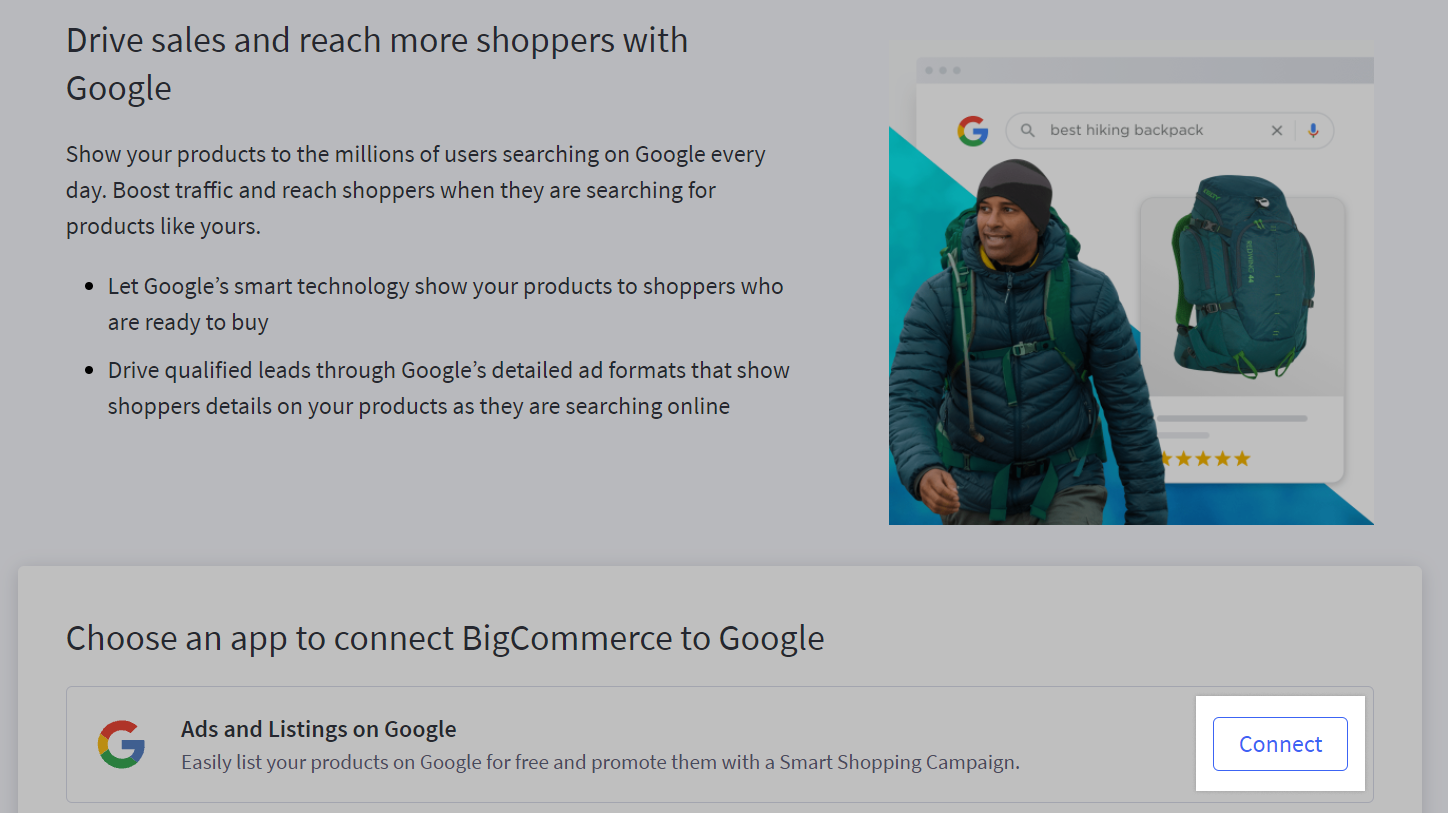
2. Select which storefront you want to sync with, then click Continue.
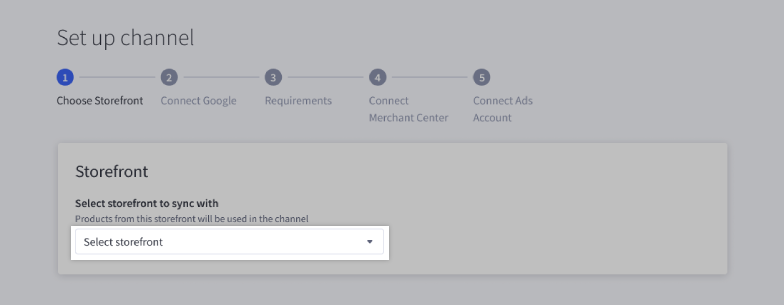
3. Click Sign in with Google and select the Google account you want to use with this storefront. Once selected, be sure all boxes are checked so BigCommerce can access your Google account. This allows the app to manage your listings, set up ad campaigns, complete site verification, and other actions necessary for the app to work.
After you've successfully connected, click Continue.
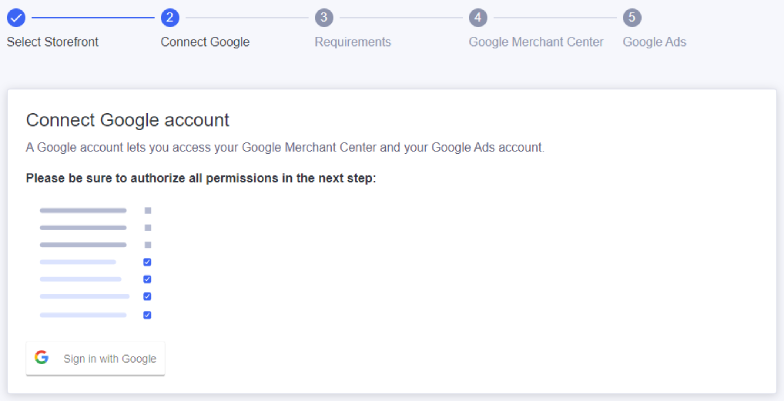
4. Confirm that your store meets Google's requirements. Click Review and confirm next to each requirement. A popup will appear with a link to the related area in the BigCommerce control panel where you can confirm your store meets the requirement, or make the necessary changes.
Once you’ve confirmed your store meets the requirement, click Confirm and move on to the next.

Google will check your store after you complete setup, so it’s important that you ensure each requirement is fulfilled before going forward. Failure to do so may result in your account being suspended, which requires additional time to resolve. If you’re not sure your store meets one or more requirements, contact our support team and we can provide guidance.
After you’ve reviewed and confirmed all requirements, click Continue.
5. Select and connect your Google Merchant Center account. If you don't already have an account, you can create a new one.
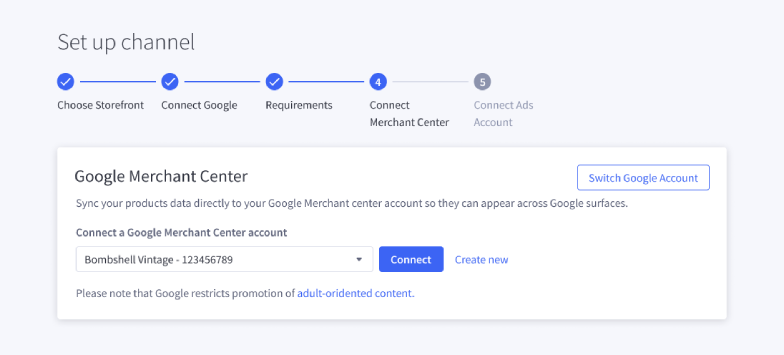
6. Select and connect your Google Ads account. If you don't already have an account, you can create a new one.
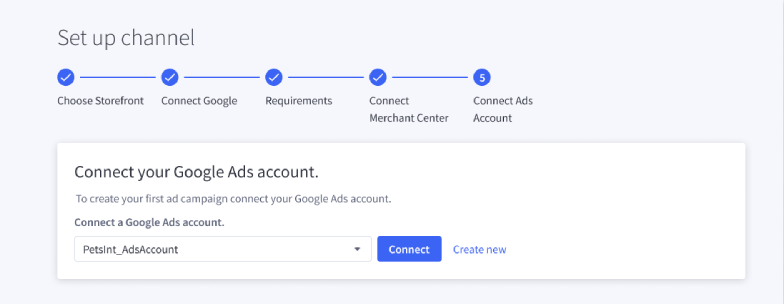
7. Click Activate channel.
Overview
This page displays the current storefront’s connection status and warnings for any item, feed, or account issues.

The Manage dropdown button allows you to disconnect a currently connected storefront. For stores with more than one storefront, you can also create a new Google channel for additional storefronts, and switch between them. See Multi-Storefront for more information.
Before your storefront’s eligible products can be included in free listings or ad campaigns, you will need to configure a few settings. Until this is done, you will see a notice on the Overview page, reminding you to complete channel setup. See Settings for more information.
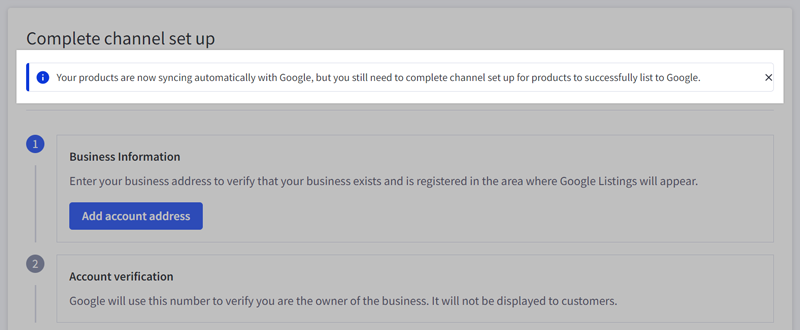
Settings
In order to list eligible products on the Google Shopping tab for free and create ad campaigns, you first need to configure a few settings in your account to avoid account suspension.
In the app, go to Settings. This page shows the storefront’s connected Google account, Google Merchant Center account, and Google Ads account, and it allows you to configure the following settings:
Business Address
Your business address is required because it verifies that your business exists and is registered in the area where Google Listings will appear.
Account Verification
Google needs to verify your phone number via text message or voice call. This helps Google protect your account, and is required.
Enter your phone number and click Verify, then select how you want to receive your verification code.
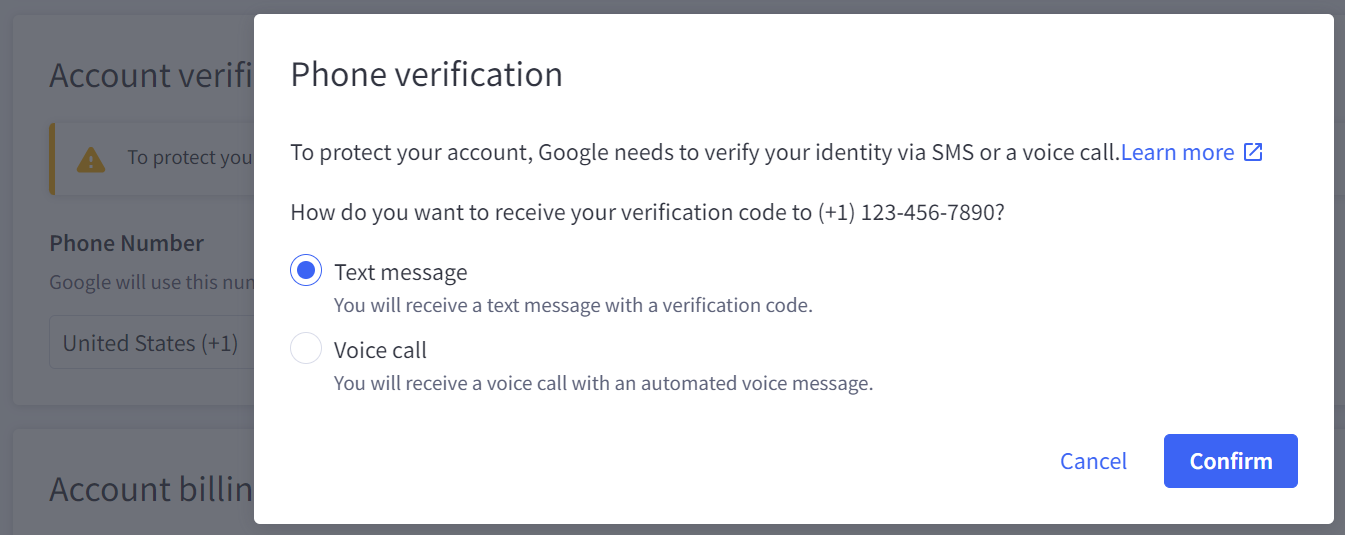
Tax Settings
Google’s destination-based tax estimation can be set up within the app. For more complex needs, you’ll need to set up taxes in your Google Merchant Center account. If you’re not sure how you should set up tax, check with your tax advisor before you make changes here.
Click Configure tax settings.
- Select Use Google’s destination-based tax estimation and add states where sales tax should be included.
- Alternatively, select Use tax settings configured in Google Merchant Center.
Check Add tax on shipping if you charge sales tax on shipping fees.
Shipping Settings
A simple flat-rate shipping method can be created within the app. For more complex shipping needs, you'll need to set up shipping in your Google Merchant Center account.
Click Configure shipping.
- Select Use a flat rate for all orders and configure your flat rate settings.
- Alternatively, select Use shipping settings configured in Google Merchant Center.
Ads Account
Google Performance Max Campaigns are billed through your Google Ads account, which is needed before you can create a campaign that reaches active shoppers.
Conversion Tracking
Before creating a campaign, you should set up conversion tracking so you can track its performance.
Go to Campaigns and click Configure tracking on the Configure conversion tracking banner.
![]()
If this is your first time setting up Google Ads conversion tracking in BigCommerce:
- Under Automatic setup (recommended), select Install conversion tracking script with BCs Script Manager and click Save. This will create a new conversion code script in Script Manager.
If you already have Google Ads conversion tracking set up in BigCommerce:
- Under Manual setup (advanced), select Setup conversion tracking manually using Google Analytics. This will use the conversion code script already set up under Settings › Data solutions › Google Analytics. Your conversion code script should be using the same Google Ads account you’ve set up in the app.
If you already have Google Ads conversion tracking set up using a custom or third-party solution:
- Under Manual setup (advanced), select Setup conversion tracking manually via a custom approach. Your conversion code script should be using the same Google Ads account you’ve set up in the app.
Products
Your products will begin automatically syncing to Google as soon as you complete the installation process. However, to avoid account suspension, you need to complete setup by configuring all required settings.
Sync
After the initial export is complete, the Products page will show you how many products are Pending review, Need attention, or have been successfully Listed.
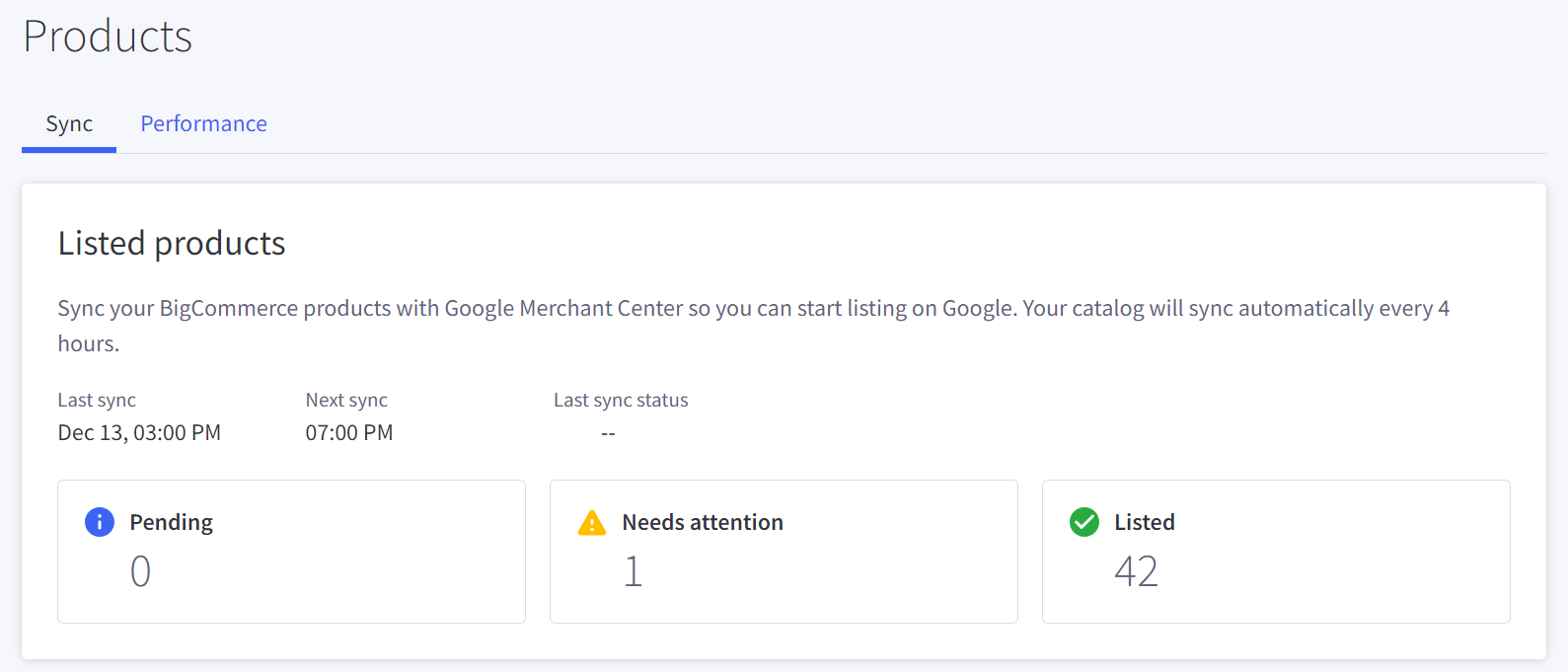
Once you have determined which products have issues that need to be resolved, you will need to edit those products directly in BigCommerce to make the required changes. Any changes to your products in BigCommerce are automatically synced with Google every 4 hours.
Performance
This area provides metrics to help you understand how well your free listings are performing, and highlights your top performing products.
- Impressions — This indicates how often your listing appeared on Google.
- Clicks — This is the total number of clicks that led to visits on your website from people who saw your listing on Google.
- CTR — This is a ratio showing how often a listing appeared on Google and led to visits on your website.
The graph provides a look at how all products have performed over time, and the search filter at the bottom of the page allows you to narrow your results down to a specific product or brand.
Ad Campaigns
Create a New Campaign
Before creating a new campaign, make sure you've set up conversion tracking.
Within the app, go to Campaigns, then click Create campaign.
- Give your campaign a name. Only you will see this.
- Set your daily budget. You can change this at any time.
- Select your target country.
- Choose which products you want to use.
- When you’re finished, click Create Campaign.
Products
When setting up a new campaign, you can choose whether to include your storefront’s entire catalog, or only selected categories, brands, or individual products.
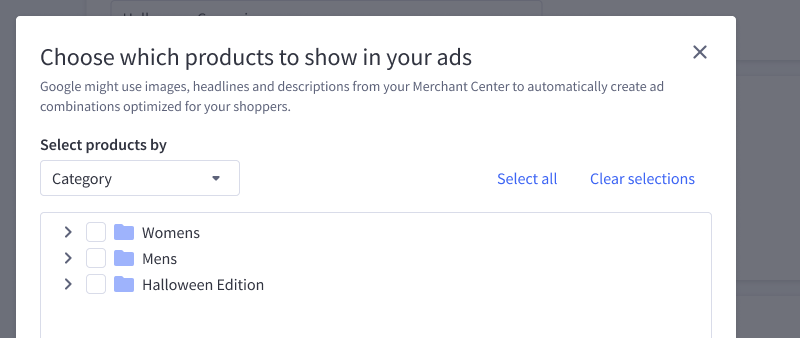
Notes about selecting products:
- Active campaigns will automatically update to include or disclude any products you add or remove from a category or brand. This does not affect your overall budget but can affect your ad spend per product.
- You can go back and edit the selected products, categories, and brands for previously created campaigns at any time.
Tracking Performance
Within the app, go to Campaigns. After your campaigns have had time to collect data, here you can get reports on performance metrics for your paid campaigns.
It takes time for Performance Max campaigns to ramp up and takes about a month to accurately evaluate performance.
- During the first 14 days, conversion and spend volume may be low.
- After 14 days, campaigns should start performing as expected. Allow another 14 days to collect data.
- After at least 28 days, it’s time to review performance and evaluate.
- Conversion lag may vary for different types of products, so some campaigns may take longer to evaluate.
Performance Metrics
The following metrics will be visible within your reports:
Impressions
An impression means how often your ad is shown. Impressions are counted each time your ad is shown on a search results page or other sites on the Google Network. Learn more about impressions here.
Clicks
When someone clicks your ad, Google Ads counts that as a click. Learn more about clicks here.
Conversions
A conversion is counted when someone interacts with your ad or free product listing (for example, clicking a text ad or viewing a video ad) and then takes an action that you’ve defined as valuable to your business, such as an online purchase. Learn more about conversions here.
Total sales
This is the total amount of sales your store has received from your Performance Max campaigns.
Total spend
This is the total amount you have spent on Performance Max ads.
Product Disapproval and Account Suspension
In-App Notifications
If your Free Listings or Shopping Ads programs are currently suspended, you should see a notification at the top of the Overview page.

Click View account issues to go to the Settings page and see the specific account-level issues that need to be resolved.
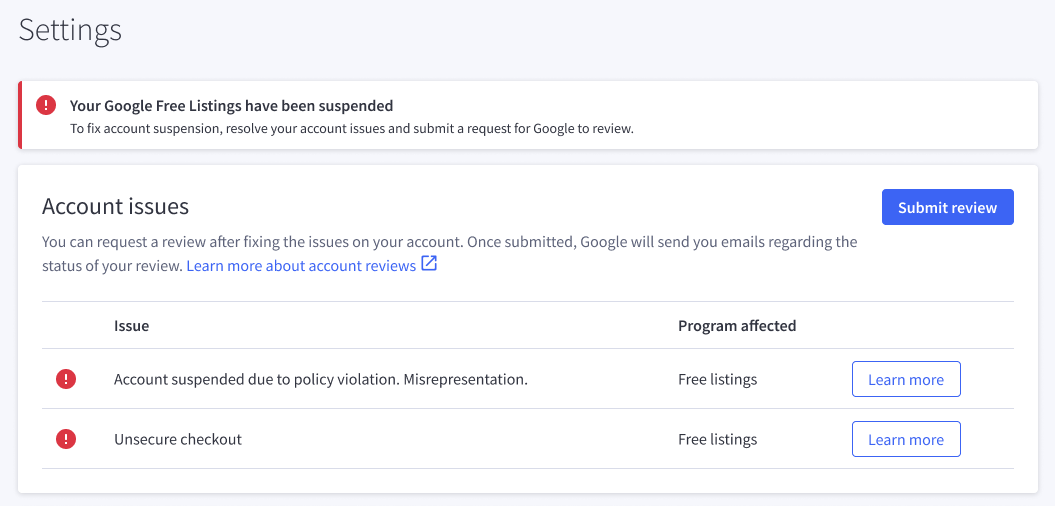
If your products have issues preventing them from being listed, you’ll see a notification at the top of the Overview page, and they’ll be listed under Item and feed issues.
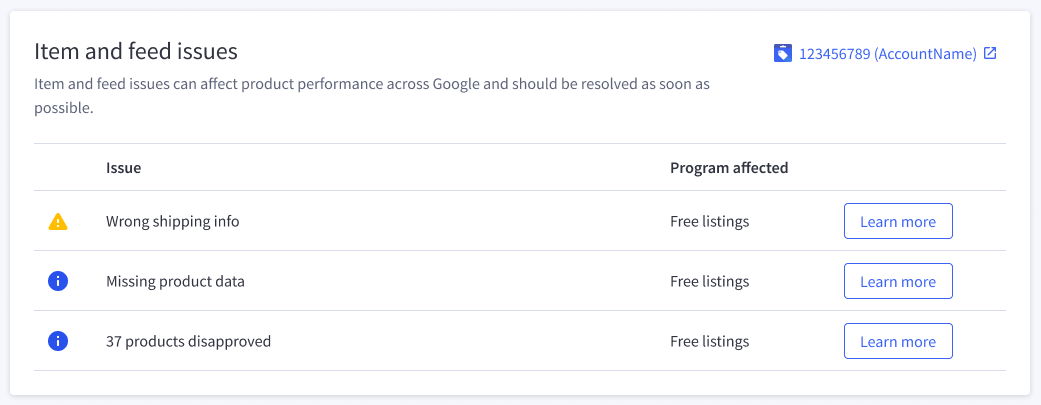
For more details, click your Account Name in the upper-right of this section to go directly to your Google Merchant Center account.
Storefront Issues
Google Merchant Center has several requirements that relate directly to your storefront. Google will check that your storefront fulfills these requirements during the onboarding process. Some examples of these requirements are:
- Your store should have terms of service and refund/return policies. These policies can exist on the same page, but make sure that they can be easily found by shoppers. BigCommerce provides a simple and easy way to create these pages if your store doesn’t already have them.
- Your store should have accurate and easily findable contact information on the storefront. You can create a contact web page to fulfill this requirement.
- Your storefront must be live and accessible. If your store is still in the development stage or has not launched, do not attempt to connect until it is ready.
Learn more about Google Merchant Center’s website requirements here.
Learn more about Google Shopping program policies and requirements here.
Product Disapproval
If your website or your products are not in compliance with Google Merchant Center requirements and Shopping ads policies, your products may be disapproved.
Some of the common product quality issues include:
- Pricing and availability mismatch between your website and your product info in Google listing. Check to see if you have “automatic syncing” enabled.
- Shipping/tax mismatch
- Low image quality for product photos or use of trademarked images
Learn more about disapprovals for product data quality violations here. Product disapprovals can lead to account suspensions in certain cases.
If you receive a warning or error about one of your products (for example, it’s missing product identifiers), you’ll need to edit the product in BigCommerce to add the appropriate data. See Adding Products (v3) for more information.
In the app, go to the Products page for a list of all item-level (product) issues. This area provides a description of the issue, and clicking the product’s SKU allows you to open it for editing/fixing.
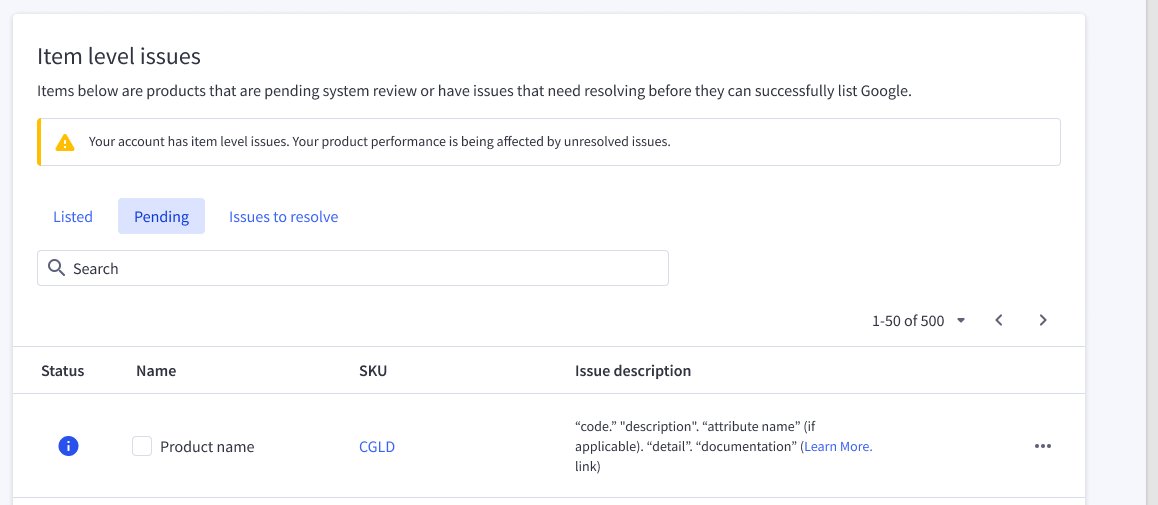
If you’re not sure why a product has a warning, error, or disapproval, or you’re not sure how to address it, contact our support team and we can help identify and fix potential issues.
Account Suspension
Common reasons that could lead to account suspension include:
- Listing items with incorrect prices.
- Listing items that violate Google policies (like weapons, recreational drugs, prescription drugs, adult-oriented content)
- Listing counterfeit items.
- Promoting prohibited items.
- Providing misleading information (misrepresentation).
- The information on your listing’s landing page does not match the listing. For example, it is a generic landing page, the language does not match, or it is missing tax and/or shipping details.
- Your storefront’s terms of service and/or refund policy is missing or is not easily found.
- Your storefront has no online purchasing means, or you have an insecure checkout. If your storefront is hosted by BigCommerce, your checkout is secure. If your storefront is hosted elsewhere, it should have an SSL certificate and we recommend sitewide HTTPS.
Learn more about account-level enforcement for policy violations here.
If your website or your products are not in compliance with Google Merchant Center requirements and Shopping ads policies, you may receive:
- A warning email: This will include details about the issue, how to fix it, and a time frame in which to fix your issues (usually seven days). In most cases, you’ll be able to fix the issue in BigCommerce by updating either your app settings or the affected product(s) details.
- An account suspension: If your issues are not fixed, you’ll receive a series of emails containing all of the relevant information related to Shopping ads policies and account suspension. Once you resolve all issues, your account or website will be reviewed and the warning will be lifted.
How do I request a re-review if my account has been suspended?
If your account has been suspended, you’ll receive an email notification, a notification will appear in the app, and you will see the specific issues affecting your account on the Settings page.
Once you’ve fixed the account suspension issue(s), use the Submit review button on the Settings page in the app.
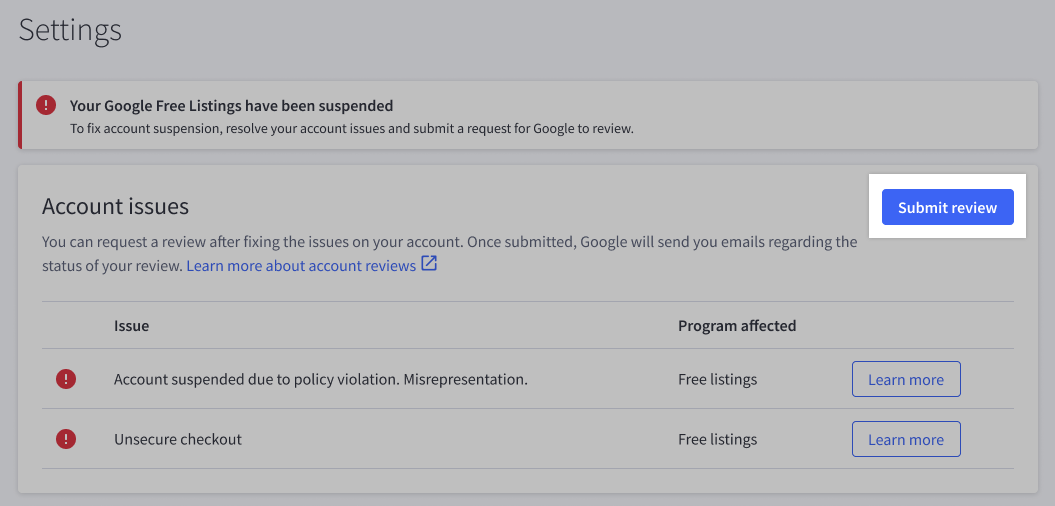
You can only request a review if there are no other pending requests. If your account has multiple policy issues in the same country of sale, the review will apply to all issues for that country of sale.
The review process can take up to three days. You can return to the Settings page later to see if your account has been re-approved, or if you still need to fix issues.

Learn more about account-level enforcement for policy violations here.
What should I do if one of my products is disapproved?
Issues will be listed on the Products page and will include all the necessary details, including the affected product name, issue, and suggested action. You can edit products individually or make edits in bulk. Your product feed will be synced automatically once the items are approved.
Learn more about disapprovals for product data quality violations here.
Multi-Storefront
After you’ve installed Ads and Listings on Google for your first storefront, you can use the app to set up and manage additional storefronts. For each storefront, you can configure different settings (like tax and shipping), list and manage products, run campaigns, and check campaign and listing performance.
Note: Your products must be associated with a storefront and visible in order to sync to Google.
Setup
On the Overview page, click Manage in the top right and select Connect new Google channel. You will go through the same setup process as your first storefront.
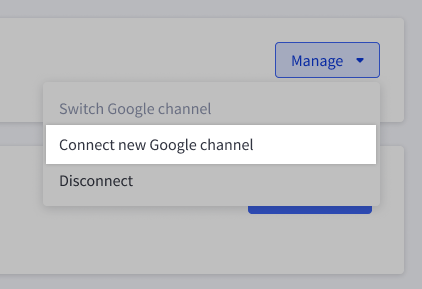
In Channel Manager, under Ads and social, you can see and manage each storefront instance of Ads and Listings on Google.

You can also go to Manage › Switch Google channel on the app Overview page to select which storefront you want to manage.
FAQ
Which countries does Ads and Listings on Google support?
The app supports all countries and currencies supported by BigCommerce.
Learn more about supported countries for Google free listings here.
Learn more about supported countries and currencies for Performance Max campaigns here.
Which languages does Ads and Listings on Google support?
Ads and Listings on Google supports the following languages:
|
|
|
*Google will deduce the script as Simplified or Traditional, which will impact traffic to your products.
Your store’s default language for shopper-facing content is set up in the Locale section of your Store Profile Settings.
How much do Performance Max campaigns cost to run?
Performance Max campaigns are pay-per-click, meaning you only pay when someone clicks on your ads. You can customize your daily budget in the app and can change this budget at any time. By default, the campaigns are set to maximize the transaction value or total sales that result from the clicks for your given budget.
Can I customize my campaign?
Yes, you can add more text and image assets to your Performance Max campaigns using Google Ads Editor. Adding more information to your campaign can boost your campaign performance while seeing the results in BigCommerce.
You can link to a campaign in Google Ads when editing the campaign in BigCommerce.
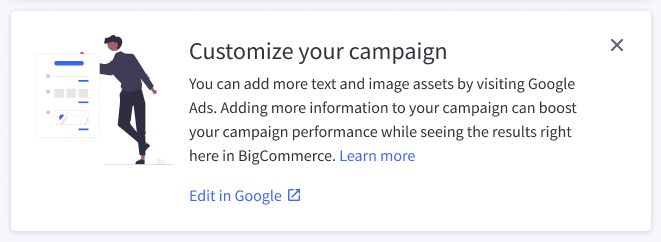
How can I get the most out of my Performance Max campaign?
Performance Max campaigns use Google’s smart technology to optimize your ads and automatically show your products to the right shoppers at the right time.
These additional tips can help you set your Performance Max campaign up for success:
-
Optimize your product data
Your product data shapes the way your ads and free listings behave and perform across Google. To make your Performance Max campaigns as successful as possible, you’ll need to provide and maintain high-quality product data.
Get more tips about optimizing your product data here.
-
Set the right budget
When exploring a new marketing channel, it can be tempting to start small, but an overly restrictive budget can prevent you from seeing performance. You can customize your daily budget in the app and can change this budget at any time. Tip: If you’re seeing a positive return on ad spend (ROAS), try to fuel even more growth by increasing your budget.
-
Create a seamless on-site experience
The success of your campaign also depends on what happens after shoppers click on your ads. Build trust by ensuring your website doesn’t include any counterfeit, false, or missing information, and consider adding customer reviews and unique selling points like fast shipping, 24/7 support, or free refunds. You may also want to boost your website quality by reducing load times and better tailoring your product images and descriptions to your customers’ needs.
Can I use an existing Google Merchant Center account that is being managed by another app, like Feedonomics?
Yes. You have two options:
- Use your existing Google Merchant Center account: You will need to disconnect and uninstall any other provider apps currently managing your account. This option is preferable as it allows you to retain your performance history associated with the account.
- Create a new Google Merchant Center account: This can be done from within the app. Your website claim will automatically be transferred to your new account. As a new account, you won’t have access to your old account’s historical data, it may take a few days to be reapproved, and performance will be impacted for a few weeks.
Why am I seeing duplicate products in Google Merchant Center?
This can happen if you have two or more apps managing the same feed. It is important that you disconnect and uninstall any other Google feed management apps (like Feedonomics) before using Ads and Listings on Google.
What happens when I delete a product in BigCommerce after it has synced to Google Merchant Center?
Products deleted in BigCommerce will be removed from your Google Merchant Center account upon the next sync.
Do I need to select a Google category for my products?
No, Google automatically assigns a category based on your product details like title, description, and identifiers.
Google Search Console is showing “Missing Field / Invalid object type” errors. What should I do?
This can be caused by missing or unsupported structured data in your theme. Cornerstone 6.2.0 and higher uses the JSON-LD method recommended by Google. You may need to update your theme, or contact your theme developer if you have a customized theme. You can use Google Search Console’s Rich Results Test to see what structured data Google is detecting at a specific URL.
 © Copyright 2003 - 2024 BigCommerce Pty. Ltd. Shopping Cart Software
© Copyright 2003 - 2024 BigCommerce Pty. Ltd. Shopping Cart Software